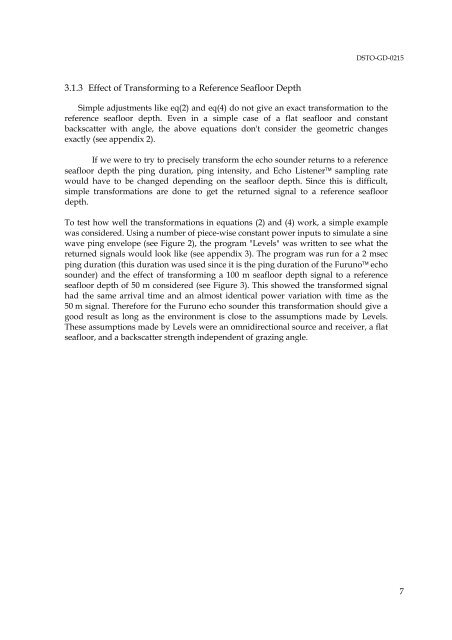The ABCS Program for the Analysis of Echo Sounder Returns for ...
The ABCS Program for the Analysis of Echo Sounder Returns for ...
The ABCS Program for the Analysis of Echo Sounder Returns for ...
Create successful ePaper yourself
Turn your PDF publications into a flip-book with our unique Google optimized e-Paper software.
DSTO-GD-02153.1.3 Effect <strong>of</strong> Trans<strong>for</strong>ming to a Reference Seafloor DepthSimple adjustments like eq(2) and eq(4) do not give an exact trans<strong>for</strong>mation to <strong>the</strong>reference seafloor depth. Even in a simple case <strong>of</strong> a flat seafloor and constantbackscatter with angle, <strong>the</strong> above equations don't consider <strong>the</strong> geometric changesexactly (see appendix 2).If we were to try to precisely trans<strong>for</strong>m <strong>the</strong> echo sounder returns to a referenceseafloor depth <strong>the</strong> ping duration, ping intensity, and <strong>Echo</strong> Listener sampling ratewould have to be changed depending on <strong>the</strong> seafloor depth. Since this is difficult,simple trans<strong>for</strong>mations are done to get <strong>the</strong> returned signal to a reference seafloordepth.To test how well <strong>the</strong> trans<strong>for</strong>mations in equations (2) and (4) work, a simple examplewas considered. Using a number <strong>of</strong> piece-wise constant power inputs to simulate a sinewave ping envelope (see Figure 2), <strong>the</strong> program "Levels" was written to see what <strong>the</strong>returned signals would look like (see appendix 3). <strong>The</strong> program was run <strong>for</strong> a 2 msecping duration (this duration was used since it is <strong>the</strong> ping duration <strong>of</strong> <strong>the</strong> Furuno echosounder) and <strong>the</strong> effect <strong>of</strong> trans<strong>for</strong>ming a 100 m seafloor depth signal to a referenceseafloor depth <strong>of</strong> 50 m considered (see Figure 3). This showed <strong>the</strong> trans<strong>for</strong>med signalhad <strong>the</strong> same arrival time and an almost identical power variation with time as <strong>the</strong>50 m signal. <strong>The</strong>re<strong>for</strong>e <strong>for</strong> <strong>the</strong> Furuno echo sounder this trans<strong>for</strong>mation should give agood result as long as <strong>the</strong> environment is close to <strong>the</strong> assumptions made by Levels.<strong>The</strong>se assumptions made by Levels were an omnidirectional source and receiver, a flatseafloor, and a backscatter strength independent <strong>of</strong> grazing angle.7
















